#Tapes & Tubes
Explore tagged Tumblr posts
Text
"i remember moments of happiness; endless summer, acoustic guitars" - SRXT, bloc party
hello again!
today we're gonna talk about my guitars for the new ep! buckle up, this is gonna be a long one.
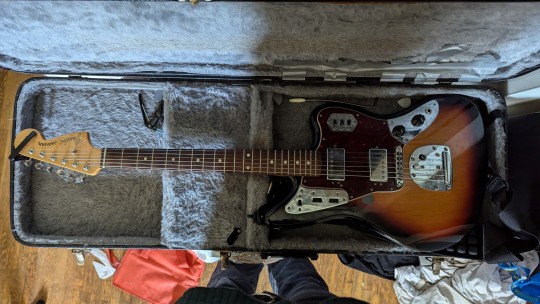
first off, i've done a about half of this ep on my stock fender classic player jaguar special hh. it's a 24" scale and it's actually tuned b to b and it sounds SO good. like. it's kind of unreal how well it holds a baritone tuning. generally, i have the neck pickup rolled off to coil split (i generally don't love a neck humbucker, honestly) and the bridge is whatever it needs to be, song by song. i don't really use the tremolo arm ever unless i'm just messing around - i try to put this thing out of tune as little as possible during a show. this guitar can do ANYTHING. it's so tonally versatile it's fucking stupid, truly. i am a lucky girl to own this.
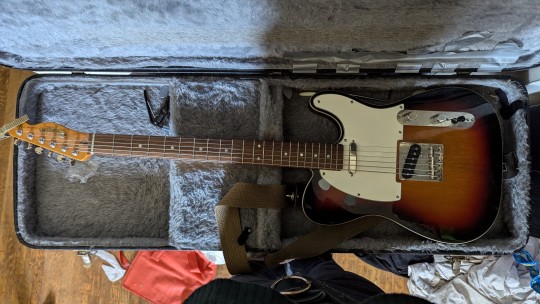
next up is the other half: my squier classic vibe baritone custom telecaster! this is also tuned b to b, but it's got a 27" scale, so it's got a much more traditional baritone sound. i have always always ALWAYS loved the versatility of a telecaster and when they put out an affordable baritone version, it was an absolute no-brainer for me. i love the range and the tonal differences that a baritone brings to indie music - thrice is one of my favourite bands of all time, and their use of baritones (and their gear in general [duh, for those in the know]) REALLY inspired me. i've been using this on a lot of the really wet stuff and the really clean stuff, but also just for some stereo guitars to lean into some tonal differences or just because it flat out feels right. i love this thing, too. it really is so flexible and fun to play (and it weighs NOTHING, which is kind of unique for a tele lol). i've replaced the output jack and jack plate and i've flipped the control panel because i'm notorious for punching my pickup selector while playing.
both guitars are strung with d'addario medium baritone strings (.14-.68).

finally, for amps and pedals... well. the future is here and i, for one, welcome our modeller overlords.
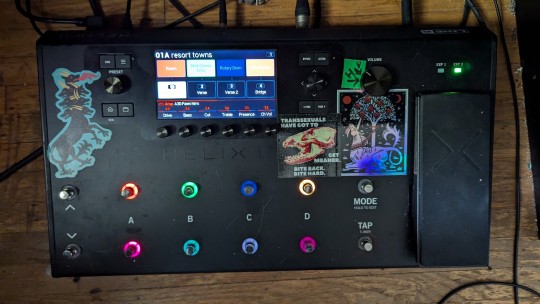
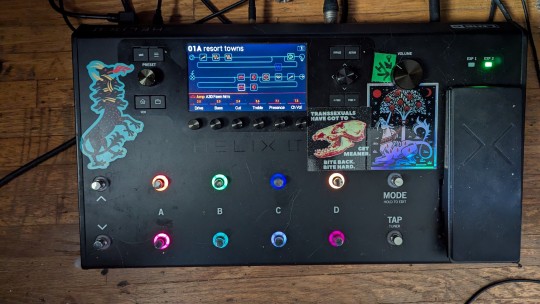
this is gonna seem like a lie based on what you're looking at here, but i'm really pretty simple with my setups - i am a set it and forget it kind of woman.
for rhythm parts, i am using a fawn vox ac30 (blue alnico) and a fender deluxe reverb (oxford) in tandem, generally being pushed by an earthquaker pillars and an xotic ep booster (bruises uses a klon, just depends on the kind of push i need). little bit of compression with the xotic sp compressor, then, as necessary for wetter parts: line 6 echo park, line 6 space chorus, a boss ce-1, a boss ac-2 and a fender vibratone (lol). in terms of helix-only effects, i'm using the line 6 heliosphere delay and hot springs reverb.
for LEADS however, we're all over the place. all kinds of shit. i generally run a higher gain amp, like a bogner shiva (uberkab t75) or a marshall jcm-800 (jensen p12q [grammatico amp]/marshall basketweave g12 m25). I was actually really pleased with how good the shiva is for lead work in our sad queer indie rock songs - this is an amp that like alice and chains and korn use and it really adds the right amount of twinkle and beautiful bummer to our songs about autism and queerness and millennial disillusionment and i just think that's such a funny juxtaposition. anyways.
for taurus, i'm using the bogner and running the xotic ep booster again, way huge red llama, dunlop mxr timmy, mxr phase 90, and auto-volume echo from the line 6 dl4. simple stuff.
for re-run, i'm using the jcm-800 and pushing it with a tube screamer when it gets huge. boss tr-2, boss dm-2 with adrian mod, tc electronic 2290, tape eater from the line 6 mm4, simple tube comp, and the line 6 feedbacker. i also have a looper set up so I can include some post-rock tremolo picked yumminess without it taking up all my focus. this is definitely my most complex rig in the helix, but even still - not too wild. like i said. set it and forget it.
so yeah! that's pretty much it for my guitars this time around. i'm gonna guess that we'll do mj's guitars next but who knows! life is a mystery and it is for living! see y'all soon.
~ elizabeth
#transgender#indie rock#trans artist#trans music#vancouver music#wearehouseguest#houseguest#houseguestband#alt rock#post rock#studio diary#updates#emo#pacific northwest emo#post hardcore#post punk#punk rock
3 notes
·
View notes
Text
And then there is the other side.
My previous post mentioned Doug Sax a few times. He is one of the old dead masters. If you search for stuff you will find lists and interviews and very much stuff. One thing that will come up is his absolute preference for vacuum tube electronics. His brother was an engineer and built all the gear for his mastering studio and it was all tube based.
His tape machines, and his mixers and his lathe cutting head amplifiers all tube. Even his digital stuff had tubes apparently and his brother even built the A/D and D/A converters they used for their CD work. (Like KODO).
In one interview I found he stated that all transistor stuff is not very good. Hey that is his preference. He slags the quality of the hearing of anyone who preferred solid state. Not polite there. NO doubt which side of the line he was on. Of course this was in the 60s so yes the Vacuum was at it's apogee while people were still figuring out solid state.
He was a musician, a trumpeter, and played in orchestras. His search for sound quality was based on professionally calibrated ears. His mastering work was first rate (but there is more).
One list I found was all the major albums he mastered. It is an impressive list. One album on that list is Carly Simon's "No secrets". I have that one and think it is not great. Great cover photo though.

It is a classic and was her big hit album. To be fair I will pull it out and play it again. My impression so far was it was massively over compressed and did not sound that good. I do not play it much for that reason. There are good and bad pressings in LP manufacturing, and knowing Doug Sax was involved makes me wonder. But is it compression or a bad pressing? Every other LP I have mastered by DS is very good indeed. I suppose the album could have been made somewhere else and someone else remastered it I will see if I can find out.
Another thing is I bought and listened to this album when the ARC amp was in the line. Will it sound better with the Franken-Amp? That would be ironic.
3 notes
·
View notes
Text
GEAR
Microphones:
Sure sm57
Sure sm58
Audix i5
Sure Beta 52
Blue Snowball
Behringer C-2 (pair)
Samson C01
Rode NT1A
Hardware:
Scarlett 18i0 audio interface
Mackie 1402-VLZ PRO 14 channel mic/line analog mixer
Guitar amps and pedals:
Helix HX STOMP
Ibanez Turbo Tube screamer
Guitars:
Fender GC140SCE Concert Acoustic-Electric
Yamaha FX335C Dreadnought Acoustic-Electric
Ovation 1311 Natural Acoustic
Fender Nashville Telecaster
Fender Squire Bullet Telecaster
Fender Squire Jazz Bass
Mitchell MU40 Soprano Natural Ukulele
Yamaha CGS 102A Classical Guitar
Keyboards:
Nektar Impact LX61+
Roland U-20
Drums and percussion:
1 big tambourine
1 small tambourine
LP Medium twist shakers
Simmons Titan 50 electronic drum set
Sound Monitoring:
JBL Professional Linear Spatial Reference 3 Series powered studio monitors (pair)
Sony Professional MDR-7506 studio headphones
Sennheiser HD 201 studio headphones
KRK Classic 5 studio monitors (pair)
Computers and visuals:
Apple MacBook Pro 13 inch
Dell flat panel monitor
DAW/software:
Logic Pro X
Pro Tools 12
GarageBand
Avid/Apple/Native Instruments/SoundToys/FabFilter/Waves plugins
Helix HX Edit
Plugins:
Digital EQ’s:
Waves V-EQ4
Fabfilter Pro-Q
Digital Reverbs:
Waves Abbey Road Chambers
Waves H-Reverb Hybrid Verb
Waves Renaissance Reverb
Waves Manny Marroquin Reverb
Relab Development LX480 Reverb
Digital Compressors:
Waves Renaissance Compressor
Waves CLA-3A Compressor/Limiter
Waves Smack Attack
Waves DeEsser
Extras:
Waves SSL G-Channel
Waves Nx Ocean Way Nashville
Waves Z-Noise
Waves WLM Plus Loudness Meter
Waves Tune Real-Time
Waves Vocal Bender
Waves Torque
Waves CLA Bass
Waves Abbey Road J37 Tape
SoundToys Echoboy
VST’s:
Spectronics Keyscapes
Native Instruments Battery
Toontrack EZdrummer 3
Native Instruments Kontakt Electric Guitar
Accessories/miscellaneous/other studio features:
4 XLR cables
4 1/4 inch jack cables
Power supply cables
USB outlet strip
High speed internet and free WIFI
Pencils, pens and paper
Wireless printer available
5 mic stands
Shock mount, pop filter, and 3 windscreens
HEAROS Ultimate Softness earplugs
Mini Samsung T.V. with Roku entertainment
RIF6 electric record player with built-in speakers
Dean Markley Pro Mag humbucker pickup
Culilux 1/4” audio splitter
Rioddas external ODD&HDD disc drive
Pack of CDs for burning
Guitar pick maker with appropriate paper
3 microphone clips
Alesis sustain pedal
Radial PRO-DI passive direct box
DeltaLab digital metronome
AKAI MPD218 beat pad
GiveBest electric heater
Behringer ULTRAACOUSTIC AT109 15-WATT acoustic guitar amplifier
OWC thunderbolt USB-C dock
APC surge protector
MOONGEL damper pads
Pick holder filled with guitar picks (floppy and hard) and a set of thumb picks
2 capos and clip on tuner
KORG TM-50 combo tuner and metronome
Mackie 1402-VLZ PRO 14 channel mic/line analog mixer
NEXIGO web cam
Big Knob passive monitor controller
The Bowman Studios, Dallas, Texas
Producers: Mason Bowman
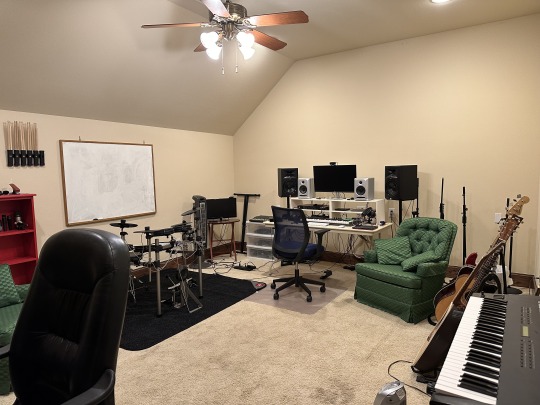
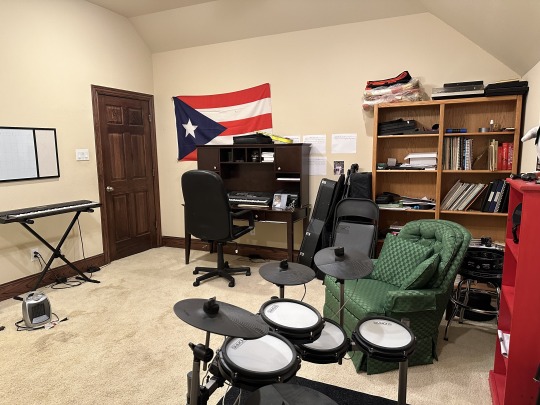
2 notes
·
View notes
Text
Dwell in spells
Strange to distill
All the horrors into a Hiku
A statement of fate
To free one’s self from fate
youtube
Perhaps a good intro is Late Night Alumni, Empty Streets, with Jay Aliyev, I Can High, “I always used to feel like, a lonely soul without a home, but now I’ve come to realize, I’m right where I belong. The city feels clean this time of night, just empty streets and me walking home to clear my head.” It has an Edward Hopper stillness to time, like Nighthawk 1942, is an eternal haunting from a previous life, for something I did. It reminds me of the nightclub I used to work at, techno and hip hop. Time has seemed to forgotten about me.
Music anthology- bare feet, 1960-70’s records in the 1980’s electronic age. Tapes, compact disks, radio stations, Deep Forest, pirate hip hop, Hendrix, bonfires, beer kegs, Eagles, and beach guitars. Night club bar work, London Techno, West Coast Rap, hard rock and heavy metal hang-out clicks.
A re-popped vintage home audio system, guitar amp conversion, has been on my mind a lot lately. Grateful Dead’s Wall of sound used MacIntosh MC-2300, Pioneer and Marantz sound very good as vintage receivers. Audio interface, and network music streamers can modernize vintage audio with Bluetooth and Wi-Fi receivers. Holy grail synthesizers include the Yamaha CS-80 that was used in blade Runner. More modest synthesizers would include The Roland JD-800 & Jupiter 8, and Korg 8 & M1, Yamaha CS-80 & DX-7, Waldorf Wave, and Minimoog.
High end Vintage table top wood case tube radio amp conversion with amp input jack and vintage microphone input jack for wind, wood and wire, and classical guitars would make a nice complement. The warm tones would suit a Cajon Drum Box and Handpan Drum. The high-end live grunge mid-range hang-out would include a nice Arabian rug, 80’s décor, bean bags, and perhaps even a lava lamp. Tape decks can record and provide backing music and a tactile interplay with live sound as a total vintage home audio aesthetic. Old equipment can be reconditioned with high-quality materials, including higher-quality insulated wires, and silver, as it is a better conductor and relatively cheap to source.
Japan came out with some Vintage Techno Hardware along the time dance music was kicking off in England and Germany. Echo units, drum machines, effect units, have a range of interactive uses and you could play electric guitar through a techno effects unit. This would all centre around a vintage analogue mixer, with complete system synthesis in functionality, style, and aesthetics.
youtube
Café Gossip
Working in the clubbing scene on a bar, looks like slave work, but I do miss the old version of me, it seems to have rotted with this idea of young love. All the relationships are broken like tea cups in a fine China shop. I may be romanticizing the potential. Sasha Alex Sloan version of Two Pilots, Dancing with Your Ghost reminds me of this lost world. An afterthought would be Zonoma & Sara Farell – Somebody Else, which is such a beautiful song. Perhaps it is in the wrong order, perhaps it is not. MollonoBass & Ava Asante - Feeling Good reminds me of the sunshine of nightwork, when the violin breaks through the clouds.
How did these beauties fall into my arms, Reflekt Feat. Delline Bass - Need to Feel Loved (Adam K & Soha Vocal Mix). Perhaps a little rain-soaked bodies under the street lamps, SOEL & Rinzen – Meliora. My love has always been greater than my reality, my mind, has always been quieter than the hope. Now it is dating by smartphone brands and credit card access. I think I am a ghost to all the love around me, or perhaps I am a god, lost in the wrong world.
It wasn’t the college experience I got, but now all the empty people of the past are stuck on Deadmau5 & Kaskade, I Remember, and apparently, it is called reflective glory. I really need to insert 4 Strings, Take Me Away here, an oldie but a goodie.
I should be more interested in things, Delerium feat. Sarah McLachlan – Silence. What does all this silence do in the end anyway? Internal narratives are a form of hell looking at itself, Sneaker Pimps - 6 Underground. When I look in the mirror, I don’t recognize the memories. There are three major fracture points in fate, high school and leaving, nightclubs and leaving, family and leaving. If I could sum it up its optimism of opportunity lost reminds me of, DJ Rui Da Silva, Touch Me.
youtube
I don’t mind losing me, I’m good, I don’t even know me. Some songs kind of remind me of being a kid, like Enya, Caribbean Blue, but its all just embellishments on stuff. I guess imagination and possibility has a high brain spark imprint, not the physical reality recall, just the feeling.
Where am I now in this reality and does it really matter, are we not all just characters in the movies and books of time, whether win or lose, we are still, just a story. Loves twisted roots, this hollow numbness, of a well-worn mask of family, writing dear life letters to the fractured truth, behind the stars singing to the clouds. Even deep inside, there is no shared shame, no teamwork, just a train wreck of lies, which becomes so firm in its roots, that to doubt it, is to hallucinate the raw reflection of time eating itself. Innocence is consumed by lies, optimism is diluted by acts, and habit is broken for momentary survival. A soft chime echoes out in the darkness; a dating app, I’m not in the mood to read it now.
Road Trip to a Small Town with a Muddy River
Life had reached some kind of climax years ago and now it resided in a manicured lawn of local emptiness. Imperial charms attract the most backwards-thinking locals, high on the notion that a building with pillars, is worth its architectural weight in gold coins, regardless if its foundations trembled from earthquake or cattle truck. It is difficult to criticize a personas mental prison over, the general pull of the town to congeal locals into a routine of, existence surrender. The dying age of several local food shops a couple decades past their due, sprung insects off the soft jelly sweets with their unnaturally hard, air-dried, outer shells. This signalled the gradual death of an old world, without a new world to embrace it.
Existence convenience was just technology from the city filling the same old tired buildings coated in white paint and rust. Life parades people like some kind of promotional tool of citizenship, in a nightly mini-series upgrade, on each new work shift, of melancholy time signature. The extroverted popular carbon copies wear well-cared-for masks, enjoying brief moments of love's fairytale, together.
youtube
Leverage intellect is a kind of revenge arch, manifesting a karmic environment of absolute control over their damaged ego. The internet created a middle ground, career-focused variant; popular culture typified as an ecosystem of fake on fake, built from a lack of participation. But in dreams, I dream of something love. I am illiterate of love, fake on fake, a tourist of my hometown, a beggar, and perhaps worst of all, a storyteller between compensation and denial, but still, I dream in curses. Love is a non-provider; a non-provider of party supplies, a non-provider of money, a non-provider of style and class, a non-provider of gifts made from all the big lies, or real love, told of other people.
Love is a toy, time is attention, hope is a deficit of promises in the hyperactive, for avoidant attention swims in symptoms of trend fantasies. Life’s still a show, and I am an unwilling actor who enjoys it from time to time, the acting that is, even when something is dying on the inside. The tragedy is a voyeur of the cultured fearful, which is almost trendy if it wasn’t replicated in every other cultural artefact. Reality is a bit of a meat grinder, but nothing makes the numbness of reality disassociate spirit from time, more; than when people chase a normal lifestyle and celebrate it as success. A muddy river runs through the old small hometown like a permanent curse, making it esthetically stagnant. Voids are character-building, but so is escapism; she is a tainted soul, with a post office in the middle, like a beacon of lost time. Pretty quickly you know it as intimately as the back of your hand and you outgrow that town quicker than others are consumed by it. It has a horror story quality to it, but for the most part, its just a museum of memories wishing for different endings.
youtube
Small Town in the Rear Vision Mirror
The world is a prison you cannot escape from, and life is a zoo that everyone can look in at. When your days are over, capitalism consumes you more efficiently as waste, than capitalism can provide a meal to the wasting bodies in waiting, wishing for the end of days. Time just gets worse and worse, spiralling out of control, and hate becomes what time sees in you, but in total delusion, love keeps telling you, fate gets better. Prettier co-workers get all the free party supplies, like trash on the side of the road, dying to some social voyeuristic curse. Admitting lost moments is a kind of naivety linked to intelligence, like the worst idea of romance, as a social trade-off to sacrificed passion, for lost normality.
Thought is just the speed of light voyeuristically living in hindsight, bizarre reality stabilizes memories as existence erodes into this pretty night, ugly day; like a soulless vampire that puts on makeup. You say to yourself, that is one of the most devious, cunning, and ruthless things, I could ever imagine; being the private joke among a group of superficial soft living types. Party kingpins to all their adventures without getting a ticket to go on anywhere wild and free, the synthetic metamorphism of adventure itself with a safety rating, old and broken.
Sun vibes and tree shade, quick winks and old buses, deluded fantasy, and road trips of make-believe, a peasant of moments, a motorbike for every thundercloud. Every animal spirit is its own island and the death of the soul is not death, but, a transition in the immortality of self-identity, as to discover a new world requires, a death in the old one. I ruled my own interpretation of life once, now the deeper dimension of the stars was the reflection of our own thoughts imagining itself to the cosmic sky never revealing good or evil, before opportunity becomes its willing sacrifice.
youtube

youtube


0 notes
Text
The International Ghostrider Collective - New Year's Day - [ R & B]
The International Ghostrider Collective - New Year's Day - [ R & B] Merry Xmas to all true music fans who value honest, original music over & above stupid red tape! Welcome to my high effort, engaging update on what is happening with the Ghosties. As you know we released our track, New Year's Day on October 3rd, check it out on Spotify or any classic streaming service. Owing to our small European Tour I was unable to provide a video to go with the song. Now that we are back I gave it my highest priority & sat down and spun out a video by myself for free. You can find it on You Tube and you know my aspirations, like, comment, subscribe and share the living ..... out of it, please!https://youtu.be/SOMINN_TkpE?si=yC-tKoY8B4L7u3of Submitted December 19, 2024 at 02:58AM by ghostriders_ https://ift.tt/etjv9HN via /r/Music
0 notes
Text
Dynaco Repair Post No. 4
Thursday evening, 12-21-23, later:
As I was saying, just a little careful polishing and the chassis already looks a lot better. And the can cap is almost exactly same height as the original:

A little more of that shine:
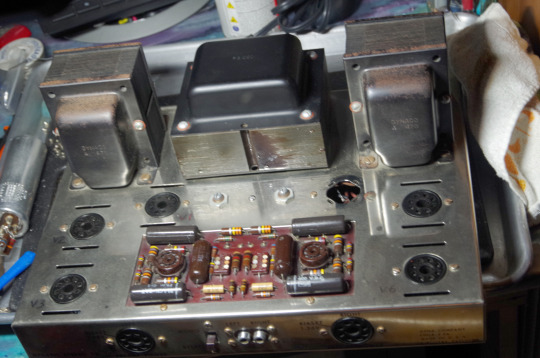
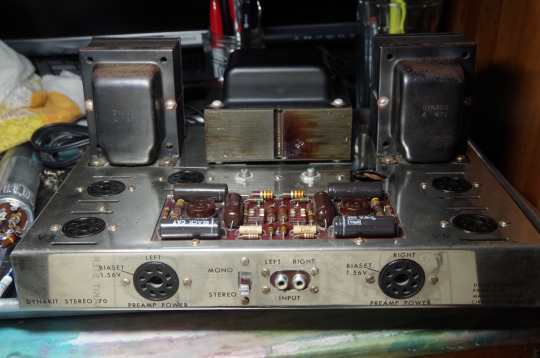
Once the new can was twist-locked into place with the four tabs, it was time to make the physical connections to all four of the terminals, and replacing the old resistors with some flameproof resistors I'd bought for another ST70 I redid about 15 years ago:
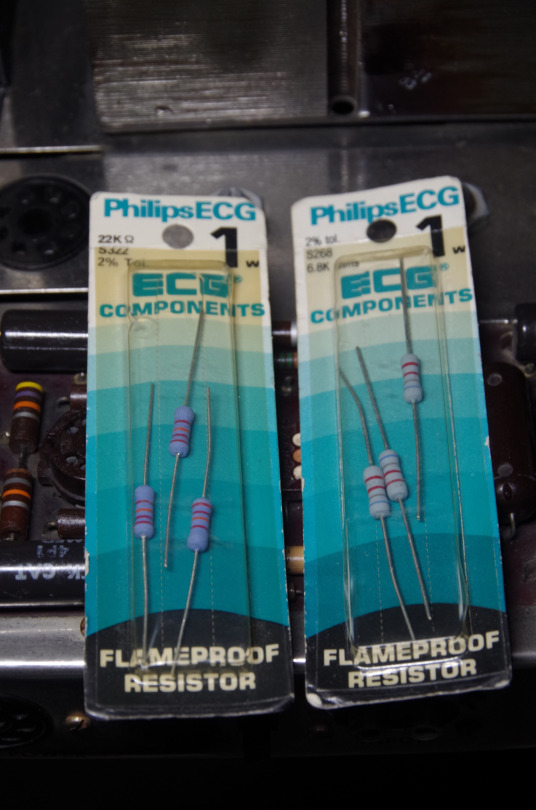

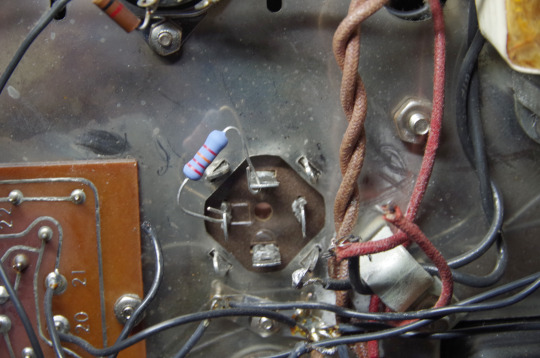
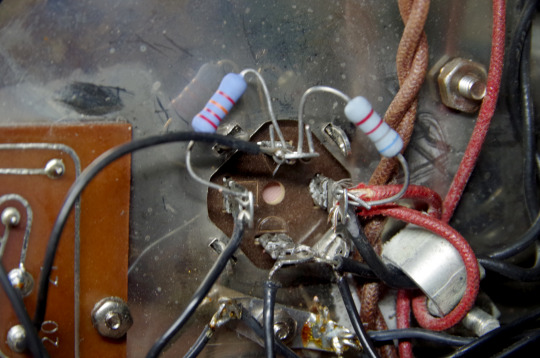
And here, finally is everything hooked up, crimped, and ready to be soldered:
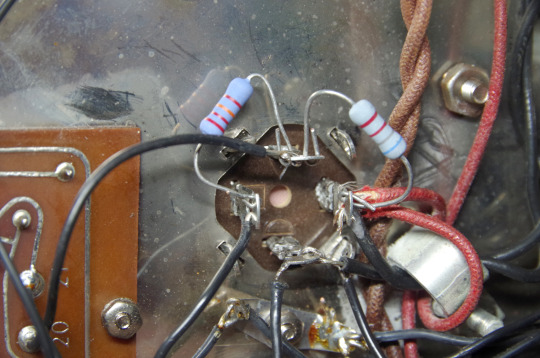
Again, the 30-watt pencil is the way to go.
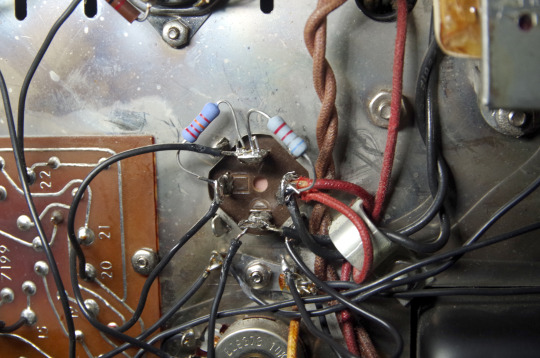
And THAT, believe it or not, completes ALL the repairs I needed to make to the Stereo 70! Now, all I need is a fresh quad of EL-34 output tubes...another $100 I don't have.
Tomorrow, I start in on finishing the PAS. The 12X4 got here, and I have work to do on the replacement switch. Dude had stripped the big flat caps wired in there, so I will have to cannibalize off my old one.
And one last "Glamour Shot", this time with the 7199 driver tubes in place, with the chassis and base shined up nicely:
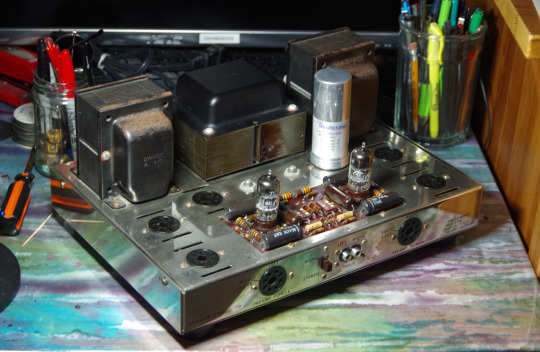
(And yes, I put these awesome big-ass rubber feet on and it is so much better looking cageless, as well as easier to handle! And I can't help thinking it has to help keep the amp cooler than the original almost non-existent flat button feet.)

Friday evening, Dec 22, 2023
Well, I looked at that 3-wafer switch, and my little "fix" of wrapping wire around the broken bits, and decided I really had nothing to lose by putting the tubes in, including the NOS 12X4 rectifier tube, and attaching some improvised wiring up to my ancient (but still absolutely functional) Altec Lansing computer speakers as an amplifier.
I then dug out the wires for the turntable and its ground, and a functioning 1/8"-to-RCA cord to use as a test for all the other inputs.
IT WORKS!!! WE HAVE PHONO! WE HAVE ALL THE OTHER PERTINENT INPUTS AS WELL! Talk about relieved and elated! WooHOO! At least now I can get back to transcribing my vinyl to SSD via this beautiful critter, my Dual 1219, with Shure M91ED cartridge. Test record? My ancient 45 of "Green Eyed Lady" by Sugarloaf! ROCK OUT ON THAT ORGAN, JERRY CORBETTA!
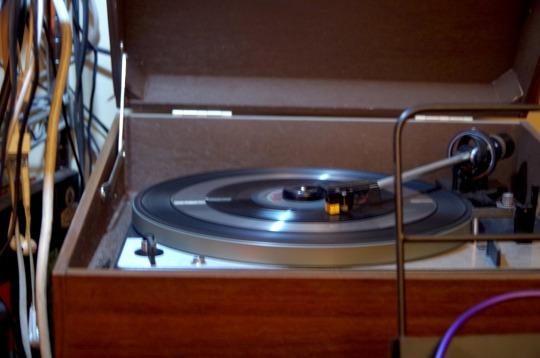
Plugged the other patchcord into my laptop, and put Miss Nina Simone's "Little Girl Blue" (which I had transcribed before this mess all went down)...and it came through excellent on the "Spare", AM/FM (tuner) input. The only one that sounded a bit off was the 'FM MPX", which was actually only supposed to be one channel of the stereo FM, so that was to be expected, actually.
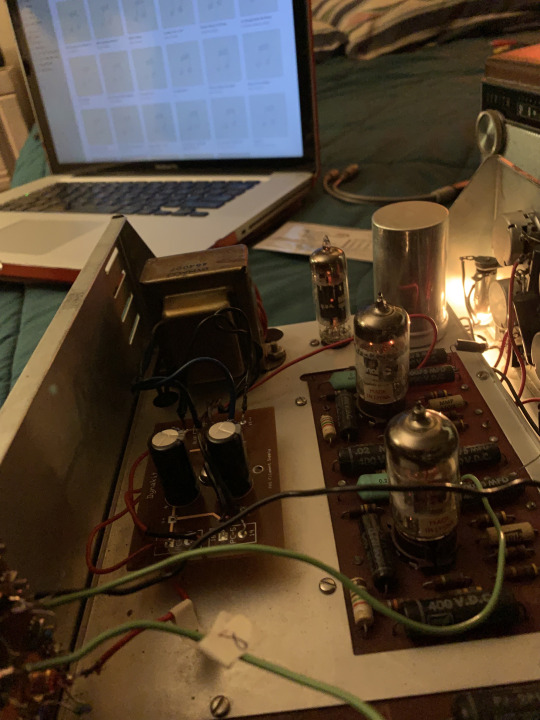
That 12X4 glowin' fine:

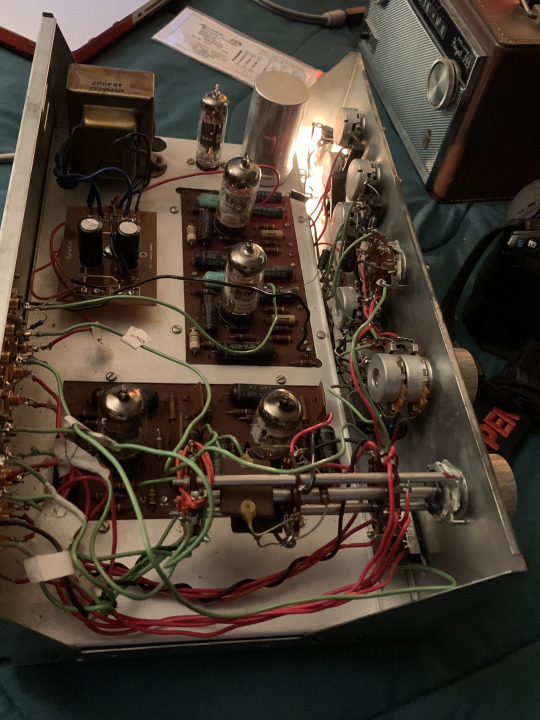
BUT: with the Spare and Phono both functional, as are the tape in/out jacks, I have everything I need, since I have a 3-source external selector box that will turn Spare into three separate additional inputs, thus, I can run my TV and DVD player into the tubes as well.
SO, I can call the PAS3X officially back in business again, and I have a spare source switch if I need it. That is big. I will spend the rest of the time this evening on putting the case back together and doing some more polishing on the ST-70.
SO the only thing we are missing for a Totally Tubular Xmas is a quad of EL34/6CA7 tubes!
More tomorrow as I finish up the detailing on both units.
And I will also show off my speakers that fill an empty spot in the Dynaco speaker line: a beast of my own creation, the speaker that never was, "The A-15" (lulz) I used 8" butyl-surround woofers and SEAS tweeters, encased in actual wood veneer Pioneer speaker cabinets.
The A-10 woofers were 6", and the A-25 were 10", these Pioneer boxes are perfectly sized to be infinite-baffle boxes, the woofers have exactly the right amount of room, and they sound amazing when the Stereo 70 is blasting through them.
AND ADDENDUM, 8:27pm: EL-34s ARE BEING MAILED TOMORROW! My bro over on the east coast is shipping them tomorrow...we will have TUBEAGE for XMAS!
-------------------------------------------
LINKS TO THE PREVIOUS THREE REPAIR POSTS:
3 notes
·
View notes
Note
I've got a tape head mounted on a sort of wand (well, a tube that used to hold mini M&Ms) wired so it plugs into a guitar amp, but I've only had limited success in getting anything more intelligible than record-scratch-esque noises out of it; I've been assuming it's a matter of getting the alignment right.

Found a quest item while on a walk. Any tips for reading unspooled cassette tape? I figure I can identify the contents even with a very small sample.
Yikes. I know you can read this more or less as-is with a reel-to-reel player of the right type, but without one I'd find a donor tape and then respool it onto there, using the pencil trick (or an electric drill at low speed).
Audio media isn't my strong point, though, so others might have better ideas.
80 notes
·
View notes
Text
Power on the Go: Car Charger Installation Guide
In our fast-paced, technology-driven world, staying connected is paramount. Whether you're commuting to work, embarking on a road trip, or just running errands, having a reliable car charger can be a lifesaver. In this article, we'll guide you through the process of installing a car charger in your vehicle, ensuring that you can power your devices on the go effortlessly.

Why Install a Car Charger?
The need for staying connected is ever-present. Whether it's for GPS navigation, hands-free calling, or charging your smartphone and other devices, a car charger is a convenient addition to any vehicle. Here's why installing one is a smart move:
Emergency Connectivity: A car charger ensures that your phone is powered up, even in emergency situations, allowing you to make calls and access vital information.
Convenience: No more worrying about low battery levels during long drives. With a car charger, you can keep your devices charged and ready for use.
GPS Navigation: GPS apps are indispensable for modern drivers. A car charger ensures that your device remains powered throughout your journey, helping you reach your destination safely.
Entertainment: Keep your passengers entertained with charged tablets, gaming devices, or portable DVD players, making road trips more enjoyable.
Selecting the Right Car Charger:
Before diving into the installation process, you'll need to choose the right car charger for your needs. Here are some factors to consider:
Type of Charger: Car chargers come in various types, including USB, USB-C, and wireless chargers. Ensure your charger is compatible with your device's charging port.
Number of Ports: Depending on your needs, select a charger with the appropriate number of ports. Some chargers offer multiple USB ports, allowing you to charge multiple devices simultaneously.
Amperage (Amps): The amperage rating of a charger determines how quickly it can charge your device. Higher amperage chargers can charge devices more rapidly.
Cable Length: Consider the length of the charging cable. Longer cables provide more flexibility for positioning devices within your vehicle.
Car Charger Installation Steps:
Once you have chosen the right car charger, follow these steps to install it:
Choose the Mounting Location: Start by selecting a suitable location for your car charger. The ideal location is within easy reach of the driver and passengers, preferably near the center console or dashboard.
Inspect the Vehicle's Electrical System: Ensure your vehicle's electrical system can support the car charger's power requirements. Consult your vehicle's manual or contact a professional if you're unsure.
Disconnect the Battery: To ensure safety during installation, disconnect the vehicle's battery. This will prevent any accidental electrical shocks.
Run the Wiring: Carefully route the charger's wiring from the chosen mounting location to the vehicle's power source. Conceal the wiring along the vehicle's interior panels or under the carpet to maintain a clean appearance.
Connect to a Power Source: Identify a suitable power source within the vehicle, typically the fuse box. Use an adapter or tap into an existing electrical connection, ensuring that the connection is secure.
Ground the Charger: Grounding is crucial for safety. Find a suitable grounding point within the vehicle and connect the charger's ground wire securely.
Connect the Charger: Attach the charger to the wiring harness, ensuring all connections are secure and insulated with electrical tape or heat shrink tubing to prevent short circuits.
Reconnect the Battery: With the charger properly installed and all connections secure, reconnect the vehicle's battery.
Test the Charger: Plug in your device to test the charger and ensure it functions correctly.
Secure the Charger: Use adhesive or mounting hardware provided with the charger to secure it in the chosen location.
For More Info:-
electric car charging melbourne
ev charging installation melbourne
tesla wall charger installation melbourne
electric vehicle charger installation melbourne
0 notes
Text
Dynamic range
I am listening to that ridiculous Sheffield Kodo Heart Beat CD. It was recorded with almost the full dynamic range the CD has to offer. Hence it is ridiculous. There are parts so quiet you must turn up the volume a lot to hear anything then it gets loud. LOUD! Perhaps one day I may see them live. They are still active as an entity. It would be an experience.
The BIG Taiko Drum on the second cut always surprises me when it first hits. It is a good excuse for triple digit Watts in your amp. A table near one speaker started to resonate, I thought maybe I hurt my woofer. No just a rattling table top.
The Franken Amp is on duty. It's working hard. It may even get warm. I gotta say it is impressive sound. The chants and shouts of the drummers are very clear. You feel the drum as much as hear it.
The lovely textures from the ARC tube amp are missing, but she could not keep up with the power demands. I have come to the position that high end amps can either reveal sounds, or enhance them. Pick one or the other. Revealing is showing you something, but not adding any extraneous sounds. Enhancing is adding something, very subtle but addition nevertheless. Take that to mean the first thing is very good solid state, the second is a high end tube amp.
OK remember I like both.
Sheffield Labs started by making direct to disk LPs. Bands would play live into a mixer and on to a disk lathe. Doug Sax one of the Demi-gods of recording engineers founded the company. If you have an original DD record you are very lucky. (I do! Tower of Power) They had safety tapes from which you can still find some CDs and maybe later LPs.
All of these had NO equalization or changes to the sound the microphones captured. KODO was recorded with a single point stereo microphone. No mixing. It is an original digital tape. That means it was put on a video tape machine as conventional ones did not have the bandwidth. So as direct from microphone to your speakers as you can get.
There is a lot of advantage to keeping the recordings simple and direct. Jazz at the Pawnshop is like that for analog. Kodo and Trinity Sessions are like that for digital. All are fully audiophile grade.
Like my being on both sides of solid state versus tubes, I play both sides of analog versus digital. I have some excellent CDs. Most are from OCD recording engineers who hold to the purity of their technique. Pure analog is good. Pure digital is good too.
Maybe one day I will get a fancier CD player. Mine is a good consumer Yamaha. It sounds fine. All of them are microchips anyway.
I did some stupid hard yard work so I am resting with lemonade and Advil. I am going to be sore tomorrow.
Hey for fun lets fire up Pink Floyd. The Wall. Oh hey it was mastered by Doug Sax too! The sound is super clear with depth and all those tricks to sound like a real thing. It is all studio stuff. Yes some dynamic range is present.
Another Brick in the Wall and all that.
And for fans of physical media the CD case has a booklet with art and calligraphy by Ralph Steadman. (Look him up droogs oh and Hunter Thompson while you are at it) Last century was weird.
2 notes
·
View notes
Text
Automotive Masking Tape | Jambs and Hood Masking Tape | Mask a Car Hood | Car Green Masking Tape
Fills any jambs & hood gaps with automotive masking tape, you can SAVE up to 30 minutes per car. Mask a Car Hood, find jamb masking tape & hood masking tape at the best price.

3/8” diameter with 1/4” diameter foam core, for modern vehicles’ tighter jambs (or put two pieces back to back to fill wider gaps)
1/2” diameter with 3/8” diameter foam core, for filling older vehicles’ larger door and hood gaps
Each tube is 48”” long.
Made with 3M™ High Performance Green Masking Tape 401+
Sticks to metal, glass, rubber, plastic and EPDM rubber moldings
Sticks in place until removed
Repositions and removes quickly and easily, with no adhesive residue
Temperature-resistant up to 250º F (121º C) for 30 minutes, so there’s no baked-on oven residue
Foam core slides out for narrow gaps (behind gas caps, for example)
Double up tubes for wide gaps
Round shape naturally feathers paint edges; ideal for masking small “target areas” for painting
Stores under normal conditions of 70º F (21º C) and 50% relative humidity in the original carton
For more info: https://www.tubetape.works/what-it-is
0 notes
Text
3 Finest Welding Practices When Making Use Of Titanium
Recognizing the most effective welding practices is necessary, especially for local business. Using titanium when welding can be tricky. As an example, if there are blue, environment-friendly, grey, violet, or white colors in titanium after welding it means there is an atmospheric contamination. Guaranteeing welding depends on criterion is essential for safety and also quality.
Titanium is really immune to corrosion. It is lighter than steel, much heavier than aluminum, and also more powerful than both of those steels. Titanium is more affordable over time because it requires little service, maintenance, and also repair service. Nevertheless, it is expensive at first. Titanium is used for armed forces, aerospace, medical, leisure, chemical processes, as well as steel ending up functions.
There are 3 welding methods that need to be adopted. Initially, it is very important to protect the heat-affected zone from the ambience up until the temperature goes down listed below 800 levels. The titanium must not begin take in oxides (oxygen, nitrogen, hydrogen, carbon) until the temperature level is below that average.
If they are absorbed too early, the weldment will certainly be embrittled as well as the item provided useless. A great technique would certainly be to check an item out initially before welding the major titanium job. The variables that allow excellent securing gas insurance coverage ought to be verified before starting.
Titanium Tube
Second, the workplace needs to be tidy. Contamination can occur from many different sources. There is oil on fingertips, lubricants, cutting fluid, paint, dust, and also extra. These can trigger embrittlement and weld failing. The workspace ought to be devoid of dust, debris, and also excess air movement that would interrupt the gas protecting mentioned over.
Third, it is crucial to utilize the proper tools to weld titanium. A power source with a high regularity arc beginning, an outcome of 250 amps, a post-flow shielding gas timer, as well as remote amperage control capabilities is the very first as well as essential device required. Polarity must be readied to right.
A lantern can be air or water cooled, based on individual devices choices. Water cooled down lanterns are smaller, manoeuvrable, and also can bond at greater temperature levels for extended durations. Water cooled down lanterns are simpler, however air cooled torches are cheaper.
To bring the required welding existing, a 2%- ceriated tungsten sized is proper. A glass lens is required to equally disperse and also produce smooth gas flow. A cup with a diameter of a minimum of 3/4 - 1 inch should be made use of. Bigger mugs allow larger welds.
A tracking guard must expand the size of the weldment. The electrode needs to prolong longer than normal to offer extended gas protection if utilizing bigger mugs or the routing guard. Normally, the electrode expands much enough for visibility and also accessibility to the joint. This can additionally be determined as one and also half times the size of the electrode.
Purge blocks are needed to give shielding gas coverage on the back and base of a joint. Several places develop their very own personalized purge obstructs from porous copper sheet and also stainless-steel. The copper serves as a gas lens by equally dispersing gas. The blocks are loaded with stainless-steel woollen to smooth gas flow a lot more.
Titanium Sheet
In some cases there are uncomfortable joints. As opposed to cleanup blocks, welders can develop shielding gas dams or chambers with stainless steel foil and fiberglass tape. Gas has to move long enough to exchange gas inside the chamber 10 times prior to welding. This makes sure pureness.
A gas manifold system distributes shielding gas to the lantern as well as purge blocks. It accomplishes this by utilizing separate gas lines with medical quality tubing, ensuring quality. Wetness content will certainly rise as round pressure decreases, so cylinders should be changed when the stress reaches 25 bar.
By having appropriate tools, maintaining a tidy work area, as well as using gas securing appropriately, titanium welding tasks will certainly not have embrittlement or failing. These methods are important to make sure high quality and security. Welding titanium suitably in the beginning will certainly permit longevity and low maintenance.
0 notes
Text
The Perseverance by Raymond Antrobus
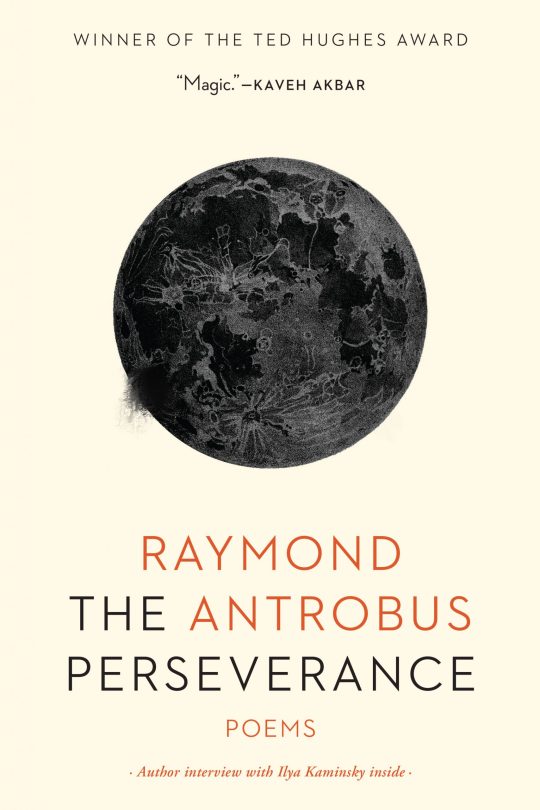
ECHO
I
My ear amps whistle as if singing to Echo, Goddess of Noise, the ravelled knot of tongues, f blaring birds, consonant crumbs of dull doorbells, sounds swamped in my misty hearing aid tubes. Gaudí believed in holy sound and built a cathedral to contain it, pulling hearing men from their knees as though Deafness is a kind of Atheism. Who would turn down God? Even though I have not heard the golden decibel of angels, I have been living in a noiseless palace where the doorbell is pulsating light and I am able to answer.
II
What?
A word that keeps looking in mirrors, in love with its own volume.
What?
I am a one-word question, a one-man patience test.
What?
What language would we speak without ears?
What?
Is paradise a world where I hear everything?
What?
How will my brain know what to hold if it has too many arms?
III
The day I clear out my dead father's flat, I throw away boxes of moulding LPs: Garvey, Malcolm X, Mandela speeches on vinyl.
I find a TDK cassette tape on the shelf. The smudged green label reads Raymond Speaking. I play the tape in his vintage cassette player
and hear my two-year-old voice chanting my name, Antrob, and Dad's laughter crackling in the background, not knowing I couldn't hear the word "bus"
and wouldn't until I got my hearing aids. Now I sit here listening to the space of deafness—
Antrob, Antrob, Antrob.
IV
And if you don't catch nothing then something wrong with your ears— they been tuned to de wrong frequency.' KEI MILLER
So maybe I belong to the universe underwater, where all songs are smeared wailings for Salacia, Goddess of Salt Water, healer of infected ears, which is what the doctor thought I had, since deafness did not run in the family but came from nowhere; so they syringed olive oil and salt water, and we all waited to see what would come out.
V
And no one knew what I was missing until a doctor gave me a handful of Lego and said to put a brick on the table every time I heard a sound. After the test I still held enough bricks in my hand to build a house and call it my sanctuary, call it the reason I sat in saintly silence during my grandfather's sermons when he preached The Good News I only heard as Babylon's babbling echoes.
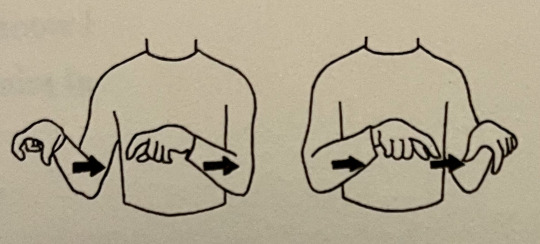
***
THE PERSEVERANCE
'Love is the man overstanding’ PETER TOSH
I wait outside The Perseverance. Just popping in here a minute. I'd heard him say it many times before like all kids with a drinking father, watch him disappear into smoke and laughter.
There is no such thing as too much laughter, my father says, drinking in The Perseverance until everything disappears— I'm outside counting minutes, waiting for the man, my father to finish his shot and take me home before
it gets dark. We’ve been here before, no such thing as too much laughter unless you're my mother without my father, working weekends while The Perseverance spits him out for a minute. He gives me 50p to make me disappear.
50p in my hand, I disappear like a coin in a parking meter before the time runs out. How many minutes will I lose listening to the laughter spilling from The Perseverance while strangers ask, where is your father?
I stare at the doors and say, my father is working. Strangers who don't disappear but hug me for my perseverance. Dad said this will be the last time before, while the TV spilled canned laughter, us, on the sofa in his council flat, knowing any minute
the yams will boil, any minute, I will eat again with my father, who cooks and serves laughter good as any Jamaican who disappeared from the Island I tasted before overstanding our heat and perseverance.
I still hear popping in for a minute, see him disappear. We lose our fathers before we know it. I am still outside The Perseverance, listening for the laughter.
***
TWO GUNS IN THE SKY FOR DANIEL HARRIS
When Daniel Harris stepped out of his car the policeman was waiting. Gun raised.
I use the past tense though this is irrelevant in Daniel's language, which is sign.
Sign has no future or past; it is a present language. You are never more present than when a gun
is pointed at you. What language says this if not sign? But the police officer saw hands
waving in the air, fired and Daniel dropped his hands, his chest bleeding out onto concrete
metres from his home. I am in Breukelen Coffee House in New York, reading this news on my phone,
when a black policewoman walks in, two guns on her hips, my friend next to me reading
the comments section: Black Lives Matter. Now what could we sign or say out loud
when the last word I learned in ASL was alive? Alive—both thumbs pointing at your lower abdominal,
index fingers pointing up like two guns in the sky.
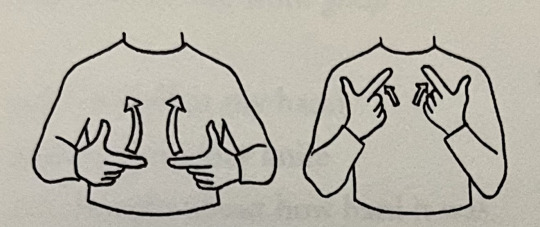
0 notes
Text
BEAT LAB
THE WAVE ALCHEMY WAY: They make innovative instruments and samples that help unlock your creativity. Designed with meticulous attention to detail, their products are lovingly made by musicians, for musicians.
Title: BEAT LAB Music Sound Company: Wave Alchemy Description: Creative drum samples recorded through acoustic rooms, tape machines, tube compressors and amps! Enter your new Beat Lab. Over 30,000 original drums… Project: Virtual instruments and sound effects sample libraries Designer: Mr DOSE

https://www.wavealchemy.co.uk/product/beat-lab/
0 notes
Text
09-11-23
OK, got both units triaged.
Yaknow those times when ya go in for an oil change and end up needin' a rebuild? Almost that. Not quite, but close.
Several "we got that goin' for us, which is nice" things, but enough stuff requiring soldering to replace shit while I'm under the hood, as it were. Below is yer handy dandy photoessay of...
Situation Dynaco '23
First thing to realize is that both of these could date from as early as '59, to as late as '71 or '72. Some possible repairs along the way, not by me. But overall? Both the preamp and power amp look quite good for their age.
Here's the innerds of the PAS preamp:

Nothing overtly terribly wrong at first glance. I definitely need to spend some hours and elbow grease on a few issues, namely cleaning all the controls. The rotary input selector is really almost immovable. I need to clean and lube it before one of those wafers cracks. One of the treble controls is frozen in full on, which is where it stays much of the time. Volume, balance, and stereo-blend need cleaning. That's not bad for a 60-70-year-old piece of gear.
Now, looking closer at what is the first obvious candidate, the power electrolytics and selenium rectifier stack, we see one of the caps is deformed and spewed some gunk.


Now this was a kit-build unit. The factory-build units used rivets instead of tiny screws and nuts to mount the PC boards and other major components. Like the hardware, like the input jack array on the back:


Two missing screws/nuts. Luckily I have spares. That could've been part of the final straw, as well. But so far? Not much else to complain about.

The quad cap is surprisingly clean. Both of the PC boards in the PAS are in great shape, no real heat damage. Might hit a few of the solder joints with a hot iron to reflow, but that's it for the PAS.


So for the PAS we're lookin' at a general clean/lube, and replace the electrolytics and put in a diode kit to eliminate the selenium stack, and we oughta be back in business.
Now, the ST-70 is in much the same shape, but it has some obviously more serious needs.
What happened with it was I was listening one afternoon and heard a slight "fizzling" sound, like the bubbling of a soft drink freshly poured. Looked over at the amp to see the left front tube glow, kinda sparkle and then when it stopped, so did the fizzling, but not before the 5AR4 and remaining EL34 on the left side glowing red, ending up with heat damage.
I shut everything down and re-routed the PAS through my venerable old Altec-Lansing computer speaker system, Beige Era. At least I could still transcribe vinyl to SSD, with my Dual 1219/Shure M91ED fed into the phono section on the PAS. with the tape out on the PAS going to the mic/sound-in port on the Mac Nehalem tower. But when the PAS failed, all bets were off, thus, I'm pushed into action to grab a soldering iron again.
So here's the Beast, that front EL34 cracked, as well. You can see the ring of heat damage on the other EL34 of the left channel. That 5AR4 rectifier was almost silverless by the time of the incident, so I'm guessing that was the first point of failure.


First time I've seen a rectifier completely DE-SILVERED from old age!

Again, remarkably clean overall underneath. You can see in the closer views below that one of the elctrolytics spewed its guts onto the side wall.



The driver board is in fairly decent shape. The heat damage to the left 7199 area is actually almost nothing compared to how dark some of them I've seen are. The excessive heat wasn't too terribly damaging, which is a good thing. The choke has never suffered a wax meltdown, which I've seen a lot, which also points to heat damage being minimal.
And yeah, I'll tell my obtuse originalist self to stfu and put a diode kit in here, too.

So for the ST-70 to live again, first it'll need a fresh matched quad of output tubes. The quad that are in there now was a matched set of Raytheons from Japan ('60s). The rectifier tube becomes meaningless when we put the diode kit in place of the selenium stack. The electrolytics are the original Dynaco parts! I'll replace them for sure, esp since it appears that one has spewed in the past.
And in the "Since yer under there anyway..." category, yeah, might as well freshen the bias pots along with the associated diode kit stuff.
So that's the situation as it stands. What'll it take? Parts money and tube money. But too much else needs payin' for first.
Last time I had to look up Dynaco parts was a good long while ago. Hopefully some of the old sites still operate. I'll look at them with an after-dinner cuppa coffee in a couple hours.
"Later that evening..."
Well, it looks like dynakitparts.com is still in the biz, so that's the go-to place for the parts. The PAS could get going with this:

plus a goodly amount of deoxit and a few hours of wearing the bifocals.
So with tax/shipping it'd be around $41 for the PAS.
The ST-70 would need the same treatment, which is oddly cheaper:

But, it will also need a matched quad of EL34/6CA7. The most like the square-shouldered "mullard clone" design I've got is gulp-inducing:

Meanwhile, the cheaper set would be JJ, which are generally good tubes:

That's still $120 plus shipping/tax, prolly close to $140 for the ST-70 to run again, plus $40 for the PAS would be $160 to get 'em both goin' with basic tubes, $250 for exact Mullard clone tubes. All of which is a pipe dream at this point.
I figured I'd need to do this sooner or later, but damn...I guess should shoot for just what the PAS needs, since it's the most reasonable. Getting the ST-70 going will have to wait.
Well fuck. I guess it was inevitable. My Dynaco PAS3X went tits up. Heard a pop and it went dark. Great. I haven’t opened it up yet to see what it was that popped. Probably a capacitor. Or one of the tubes might’ve given it up.
So it sits there, along with the ST70 that needs an output tube and probably more. A buddy was supposed to send me one, but it’s been nearly two years he was gonna send one.
See? This is why being broke sucks. There is no “discretionary income” for poors. None. Unless you can fix it with spit and duct tape, you are just fucked.
Until I can fix at least the PAS3X, my vinyl transcribing is effectively on hold. My turntable fed into the PAS3X and its tape output went into the Mac Tower. Beautiful sound on the transfers of what I’ve gotten made so far.
Very few will even know wtf I’m talking about.
Just an old man kvetching.
Go back to sleep.
18 notes
·
View notes
Text
Battle Lines.
Many conflicts occur from misunderstandings. Those lead to opinions and different opinions lead to taking sides. Criticism of what I think is criticism of me. Wanna fight? I just watched an interesting You Tube video on digital recording. (see below) They talk about sample rates and bit depth and well stuff which engineers deal with in audio. Interesting they relate bit depth directly to tape noise.
The consumer or audiophile listener has to take a side right? I mean I have said many times I prefer my analog source of LPs to Streaming and CDs. The fight between digital and analog is very similar to the solid state versus glass conflict. You wanna fight?
But recently I have gone on about how I have some really good CDs. There are true audiophile CDs even with the limits of 16 bit and 44 khz.
My CD player is good, but not high end. It costs less than my current phono pickup. But good can be pretty good.
I am beginning to lean on the idea that it is the recording and processing of the disc (either shiny clear, or big black type) that is the big difference. A poorly done recording and a ham fisted mastering will make a poor playback no matter how fancy and expensive your music spinner is. Or for that matter if it is digital or analog.
And there is a direct parallel between how a digital signal can go bad and how a solid state or tube amplifier can sound good or bad. Clipping is a word used when a signal exceeds the capacity of a medium to portray it. In a power amplifier tubes are always praised for how they clip. Overdrive them and they keep pretty calm and if you are a guitar player they make nice distortion sounds. A solid state amplifier reacts dangerously with nasty harmonics and even gobs of DC to blow speakers. Personally in audio I think if you are clipping an amp you have got something seriously wrong.
I get frustrated when people go on and on about how tubes clip nicely or better. Why clip anything at all? It can explain why a relatively small tube amplifier, say 60 Watt, can sound as good as a much bigger solid state one of 240 Watts. But generally clipping is something to be avoided. Don't do it!
In digital recording if you clip a signal it generates harmonic artifacts that sound very bad. So much of poor CD sound can be from bad recording or conversion from analog to digital at the front end of the process. Done right it sounds fine.
youtube
The debate about bit depth is also a distraction. A CD has much more Dynamic Range than an LP, but an LP is adequate for almost all music. Sound effects maybe not.
In one of my discussions with the Tube Guru he used the analogy of hearing a bee buzzing on the other side of the garden then it gets hit by a lightning bolt. That is about the DR that a CD is capable of. Need that much?
The real application is in the recording and studio mixing phase where more bits give you lower noise so layering tracks will not lose everything into hiss. Higher bit rates are to facilitate analog input filters of easier slope to prevent frequencies above the Nyquist limit from getting in. That is a problem at the front end.
I like reasoned factual discussion. You can still like this or that, but lets not fight. There still is no best, just preferences. Enjoy the sounds.
#audiophile#high end audio#audioblr#cheap audiophile#tubes vs transistors#telarc digital#digital versus vinyl#Youtube
2 notes
·
View notes
Text
In Memory of John Peel Show 210409 Podcast & Playlist
In Memory of John Peel Show 210409 Podcast & Playlist
Jane Fonda “keep doing this essential work” >>> the best new music, independent of the industry system – back this show on patreon Paypal to [email protected] heard in over 90 countries via independent stations https://radiopublic.com/in-memory-of-john-peel-show-6nVPd6/ (RSS)Pod-Subscribe for free here or embed/listen at podomatic – itunes here’s the latest…

View On WordPress
#a/lpaca#Alessandro Baris#Duo Odio#john peel#Lithics#Mark Trecka#Melby#new music#Ono#Passepartout Duo#R. Dean Taylor#Ringhof#Simona Zamboli#Slagheap#Tapes & Tubes#Wendy Eisenberg#Yang Chun Jin And Yang Bao Cheng#Zaph Mann
1 note
·
View note